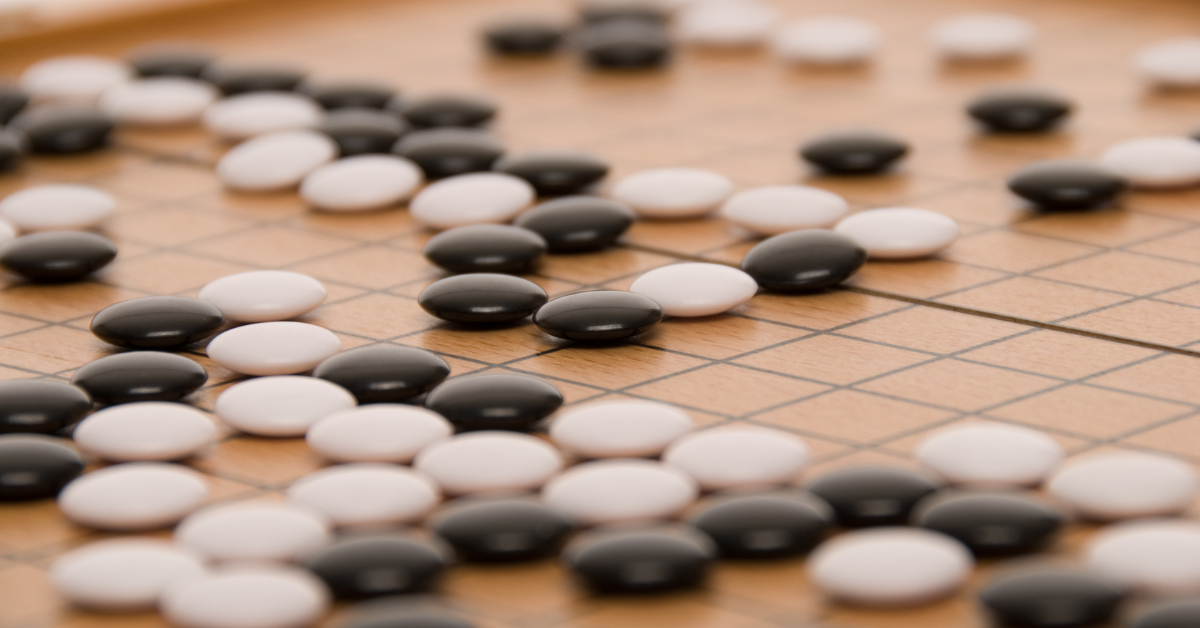Go, known in Japan as Igo, is a board game with simple rules but infinite depth. It originated in China over 4,000 years ago and has since become a cultural treasure in Japan, Korea, and beyond. Today, it is enjoyed globally under the name “Go,” connecting people across cultures and generations through strategic thinking and quiet dialogue.
Basic Rules of Go
Go is played on a board where players alternately place black and white stones on the intersections. When a group of stones is completely surrounded, it is captured and removed from the board. The goal is to control larger territory than the opponent by the end of the game.
| Term | Meaning |
|---|---|
| Go board | A board with a 19×19 grid |
| Stones | Black and white round pieces |
| Territory | The area enclosed by one’s stones |
| Atari | A state where a stone can be captured immediately |
| Ko | A rule preventing infinite repetition of capture |
Beginners are advised to start with smaller boards such as 9×9 or 13×13, which make it easier to grasp the flow of the game. Once familiar, they can move on to the full 19×19 board to experience the depth of Go.
History and Expansion of Go
Go originated in ancient China and is said to have a history of around 4,000 years. It was considered a noble pastime, valued for developing strategic thinking and mental discipline.
It spread to Korea and Japan, where it flourished. In Japan during the Edo period, Go was highly respected and supported by the shogunate. The “Four Go Houses” produced experts, and the annual “Castle Games” held before the shogun were major events.
In modern times, Go reached Europe and America, and by the 20th century, international tournaments were being held. In the 21st century, artificial intelligence changed the landscape. In 2016, the AI program AlphaGo defeated one of the world’s top players, stunning the world and sparking renewed global interest in Go. Today, Go is studied by both humans and AI as a shared intellectual challenge.
The Appeal of Go
There are several reasons why Go continues to fascinate people.
- Simple rules, infinite possibilities
The act of placing stones is simple, yet the possible variations are countless. No two games are ever the same, offering endless discovery. - A quiet dialogue between players
Go allows communication without words. Each move reflects the player’s thoughts and personality, creating a form of silent conversation. - A game for all ages
Children can enjoy it as a game, adults as a battle of strategy, and seniors as a way to stimulate the mind.
Steps for Beginners
Here is a step-by-step approach for those who want to start learning Go.
| Step | Description | Key Point |
|---|---|---|
| 1 | Practice on a 9×9 board | Learn rules with a small board |
| 2 | Understand capture and Atari | Learn the sense of taking stones |
| 3 | Practice expanding territory | Build the habit of thinking about space |
| 4 | Move to the 19×19 board | Enter the full world of Go |
| 5 | Review professional game records | Experience master-level moves |
Learning step by step is the fastest way to improve. Today, online platforms allow players to compete with others worldwide. AI opponents are also available, offering practice opportunities for beginners to professionals.
Go Around the World
Today, Go is played not only in Asia but also in Europe, the Middle East, and Africa. Associations exist in many countries, and international tournaments are held regularly.
| Region | Feature | Current Status |
|---|---|---|
| Japan | Professional system established | Many active professionals |
| China | Large player base | Produces top global players |
| Korea | Strong rise of young players | Excellent results in world events |
| Europe/US | Used in education | Spread in schools and universities |
| Africa | In early stages of growth | Programs for children expanding |
Go is also gaining attention in education. It is valued as a tool to develop logical thinking, concentration, and respect for others.
Go and Artificial Intelligence
In recent years, Go and AI have become inseparable. Since AlphaGo’s emergence, AI has revealed many novel strategies that surprised even top professionals.
| Year | Event | Significance |
|---|---|---|
| 2016 | AlphaGo defeats a top player | Symbol of the AI era |
| 2019 | Global AI research accelerates | Expanded study by professionals |
| Today | AI as a learning partner | Used by beginners and pros alike |
AI is no longer a threat but a partner in learning. Human and AI collaboration is pushing Go research forward at unprecedented speed.
Conclusion
Go is a 4,000-year-old game that continues to evolve today. Its rules are easy to learn, yet every game presents fresh challenges. Recognized globally as “Go,” it connects people across cultures and generations.
Beginners should start with small boards and gradually advance, using AI and online play to improve. Through Go, players not only sharpen logic and concentration but also find opportunities for international exchange. The true charm of Go lies beyond victory or defeat—it is the joy of endless discovery.






